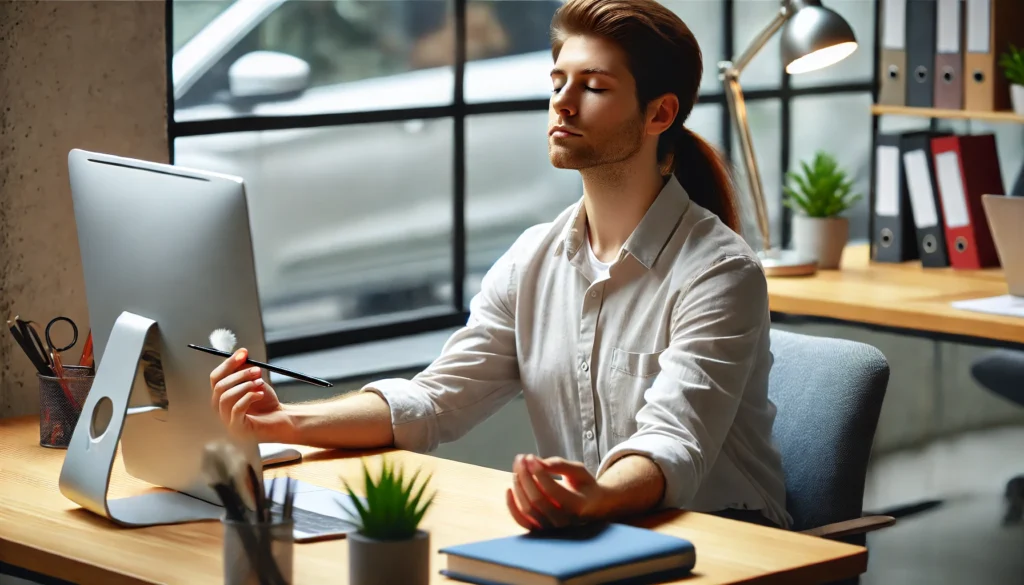Anxiety is a common companion in our fast-paced world, often lurking in the shadows of our minds, waiting to pounce at the most inconvenient times. Whether you’re a health and wellness coach seeking actionable solutions for clients, a science journalist delving into the complexities of the human psyche, or a biohacker optimizing mental health, understanding quick and effective anxiety exercises is crucial. This comprehensive guide will delve into exercises for anxiety relief that you can employ anywhere, anytime.
You may also like: Effective Stress Management Techniques for Daily Life
Understanding Anxiety and Its Triggers
Anxiety, in its essence, is a natural response to stress, characterized by feelings of tension, worried thoughts, and physical changes like increased blood pressure. While occasional anxiety is a normal part of life, chronic anxiety can interfere with daily activities and well-being.
The Biological Foundation of Anxiety
Our bodies are hardwired to respond to threats through the fight-or-flight mechanism. This response involves a cascade of hormones and physiological changes designed to prepare us for danger. In modern society, however, this response often gets triggered by non-life-threatening stressors, such as work deadlines or social pressures, creating a disconnect between our physiological reactions and the actual threat level.
Psychological and Environmental Triggers
Anxiety can be triggered by a wide range of psychological factors, including personal experiences, trauma, or even genetic predispositions. Environmental influences such as high-pressure environments, societal expectations, and even technology overload can exacerbate these triggers. Understanding these factors can help in identifying personal anxiety patterns.
The Role of Lifestyle and Habits
Lifestyle choices and daily habits can significantly influence anxiety levels. Poor sleep, lack of physical activity, and unhealthy eating patterns can contribute to heightened anxiety. Conversely, adopting a balanced lifestyle with regular exercise and a nutritious diet can help mitigate anxiety symptoms. Recognizing the impact of these habits is essential for comprehensive anxiety management.
The Science Behind Anxiety Exercises
Anxiety exercises are designed to interrupt the body’s stress response and promote relaxation. These exercises work by engaging the parasympathetic nervous system, which counteracts the fight-or-flight response. Techniques such as deep breathing, progressive muscle relaxation, and mindfulness meditation are scientifically validated methods for reducing anxiety symptoms.
Activating the Parasympathetic Nervous System
The parasympathetic nervous system acts as a counterbalance to the stress response, promoting a state of calm and relaxation. Through specific exercises, we can activate this system, reducing heart rate and promoting a sense of peace. Understanding the mechanisms behind these exercises can enhance their effectiveness.
Neurotransmitters and Hormones in Play
Engaging in anxiety-reducing exercises can influence the production of neurotransmitters and hormones associated with mood regulation. For example, serotonin and dopamine levels can be positively affected, contributing to improved mood and decreased anxiety. Recognizing the biochemical changes can provide motivation to maintain consistent practice.
Evidence-Based Techniques for Anxiety Reduction
Research supports various techniques for anxiety reduction, each with its unique benefits. Deep breathing, progressive muscle relaxation, and mindfulness meditation have been extensively studied, demonstrating their efficacy in reducing anxiety symptoms. Exploring these techniques in detail can help individuals select the most suitable method for their needs.
Deep Breathing Exercises
Deep breathing is a foundational exercise for anxiety relief, leveraging the power of the breath to calm the nervous system. By focusing on slow, deep breaths, you can reduce heart rate and induce a state of relaxation.
The Physiology of Deep Breathing
Deep breathing exercises engage the diaphragm, promoting efficient oxygen exchange and stimulating the vagus nerve, which plays a key role in calming the nervous system. Understanding this physiological process can enhance the effectiveness of deep breathing exercises.
Techniques for Effective Deep Breathing
Several techniques can be employed to maximize the benefits of deep breathing. These include box breathing, 4-7-8 breathing, and alternate nostril breathing. Each technique offers unique advantages and can be adapted to suit individual preferences and situations.

Incorporating Deep Breathing into Daily Life
Deep breathing can be seamlessly integrated into daily routines, providing a quick and accessible method for managing anxiety. Practicing deep breathing during stressful moments, such as before a meeting or presentation, can help maintain composure and focus.
Progressive Muscle Relaxation
Progressive muscle relaxation (PMR) involves systematically tensing and then relaxing muscle groups in the body. This exercise helps reduce physical tension associated with anxiety, promoting a sense of calm.
Understanding Muscle Tension and Anxiety
Anxiety often manifests physically through muscle tension, leading to discomfort and exacerbating stress. PMR aims to address this tension directly, promoting relaxation and reducing anxiety-related physical symptoms.
Step-by-Step Guide to Progressive Muscle Relaxation
A structured approach to PMR involves starting from the toes and working upwards through the body. Each muscle group is tensed for a few seconds before being relaxed, allowing individuals to experience the contrast between tension and relaxation.
Combining PMR with Other Techniques
PMR can be enhanced by combining it with other anxiety-reducing techniques, such as deep breathing or visualization. This combination can create a more comprehensive relaxation experience, addressing both physical and mental aspects of anxiety.
Mindfulness Meditation
Mindfulness meditation encourages present-moment awareness, helping individuals detach from anxious thoughts. By focusing attention on the here and now, mindfulness can alleviate the mental spirals that often accompany anxiety.
The Principles of Mindfulness
Mindfulness is rooted in the concept of non-judgmental awareness, encouraging individuals to observe thoughts and sensations without attachment. This approach can help break the cycle of anxious thinking and promote a sense of peace.
Techniques for Practicing Mindfulness Meditation
Mindfulness meditation can be practiced through various techniques, including body scan meditation, loving-kindness meditation, and mindful breathing. Each technique offers a unique path to cultivating awareness and reducing anxiety.
Integrating Mindfulness into Everyday Activities
Mindfulness can be incorporated into daily activities, transforming mundane tasks into opportunities for meditation. Practicing mindfulness while eating, walking, or even washing dishes can enhance awareness and promote relaxation.
Quick Anxiety Exercises for On-the-Go Relief
For those moments when anxiety strikes unexpectedly, having a repertoire of quick exercises can be invaluable. Here are some exercises designed for rapid implementation:
5-4-3-2-1 Grounding Technique
The 5-4-3-2-1 technique is a grounding exercise that uses the five senses to create a momentary distraction from anxiety.
Sensory Engagement and Distraction
By engaging the senses, this technique shifts focus away from anxious thoughts and into the present moment. This sensory engagement can provide a powerful distraction, breaking the cycle of anxiety.
Practical Steps for Implementation
Practicing the 5-4-3-2-1 technique involves identifying sensory experiences in the environment, such as sights, sounds, and textures. This step-by-step approach can be practiced anywhere, offering immediate relief.
Adapting the Technique to Different Situations
The 5-4-3-2-1 technique can be adapted to suit various environments and personal preferences. Whether in a crowded space or a quiet room, this technique provides a versatile tool for managing anxiety.

Visualization
Visualization involves imagining a serene environment or situation to reduce anxiety.
The Power of Imagery in Reducing Anxiety
Imagery can transport the mind to a place of calm and safety, creating a mental escape from anxiety triggers. This technique leverages the brain’s capacity for imagination to foster relaxation.
Steps to Effective Visualization
Effective visualization involves focusing on a peaceful scene and engaging all senses to create a vivid mental picture. This practice can be tailored to individual preferences, enhancing its calming effect.
Combining Visualization with Other Techniques
Visualization can be combined with other anxiety-reducing exercises, such as deep breathing or mindfulness, to create a more comprehensive relaxation experience. This combination can enhance the effectiveness of visualization.
Future Implications of Anxiety Exercises
As awareness of mental health grows, the demand for accessible anxiety relief methods will continue to rise. The integration of technology, such as mobile apps and wearables, offers promising avenues for enhancing the effectiveness and accessibility of anxiety exercises.
The Role of Technology in Anxiety Management
Technology can provide innovative solutions for anxiety management, offering tools such as guided meditation apps and wearable devices that monitor stress levels. These advancements can make anxiety exercises more accessible and personalized.
Personalized Anxiety Relief Solutions
With the help of data-driven insights, technology can offer personalized anxiety relief solutions tailored to individual needs. This personalized approach can enhance the effectiveness of anxiety exercises, providing targeted support.
The Future of Anxiety Management
The future of anxiety management looks promising, with ongoing research and technological advancements paving the way for innovative solutions. As we continue to explore these possibilities, anxiety exercises will become an integral part of comprehensive mental health care.

Conclusion
Incorporating anxiety exercises into daily routines can empower individuals to manage stress effectively, improving mental health and overall well-being. Whether you’re seeking to provide clients with practical advice, translate complex scientific concepts, or optimize your mental health, these exercises offer a versatile solution for on-the-go anxiety relief. As we continue to explore the intersection of technology and mental health, the future of anxiety management looks promising and innovative.
By embracing these exercises, you can take proactive steps toward a calmer, more centered existence, transforming anxiety from a debilitating foe into a manageable aspect of life.
Further Reading:
Five Exercises That Help Manage Anxiety—And One You Might Want to Avoid
3 Easy Anxiety Relief Exercises You Can Use Anywhere
Important Note: The information contained in this article is for general informational purposes only, and should not be construed as health or medical advice, nor is it intended to diagnose, prevent, treat, or cure any disease or health condition. Before embarking on any diet, fitness regimen, or program of nutritional supplementation, it is advisable to consult your healthcare professional in order to determine its safety and probable efficacy in terms of your individual state of health.
Regarding Nutritional Supplements Or Other Non-Prescription Health Products: If any nutritional supplements or other non-prescription health products are mentioned in the foregoing article, any claims or statements made about them have not been evaluated by the U.S. Food and Drug Administration, and such nutritional supplements or other health products are not intended to diagnose, treat, cure, or prevent any disease.


